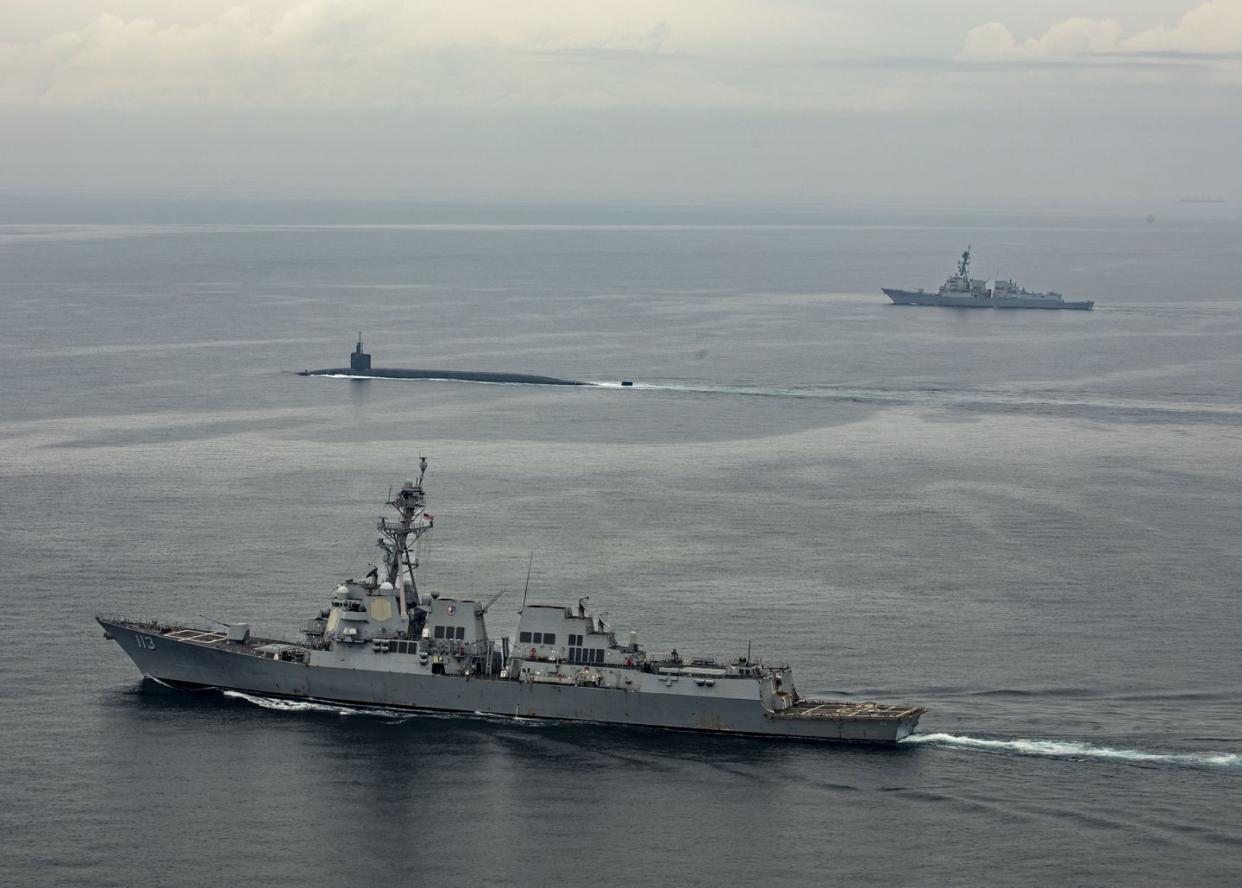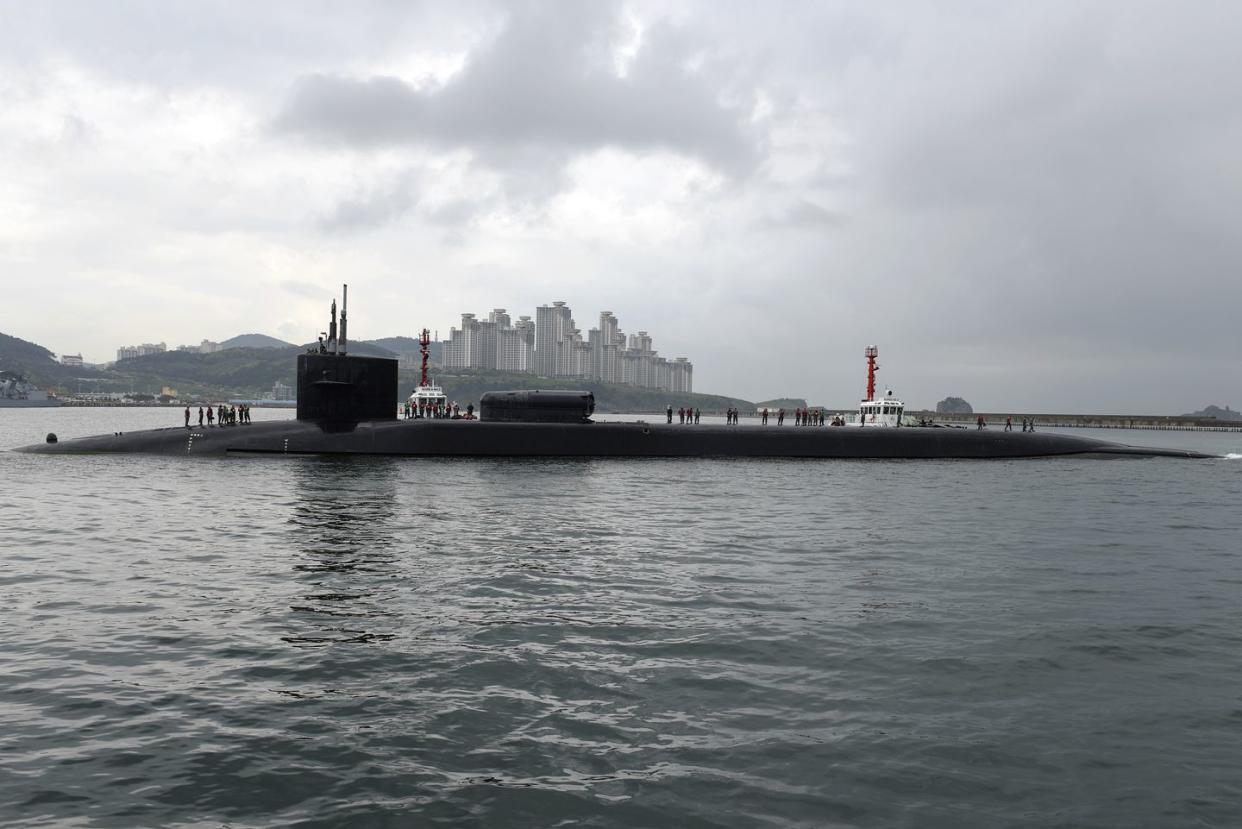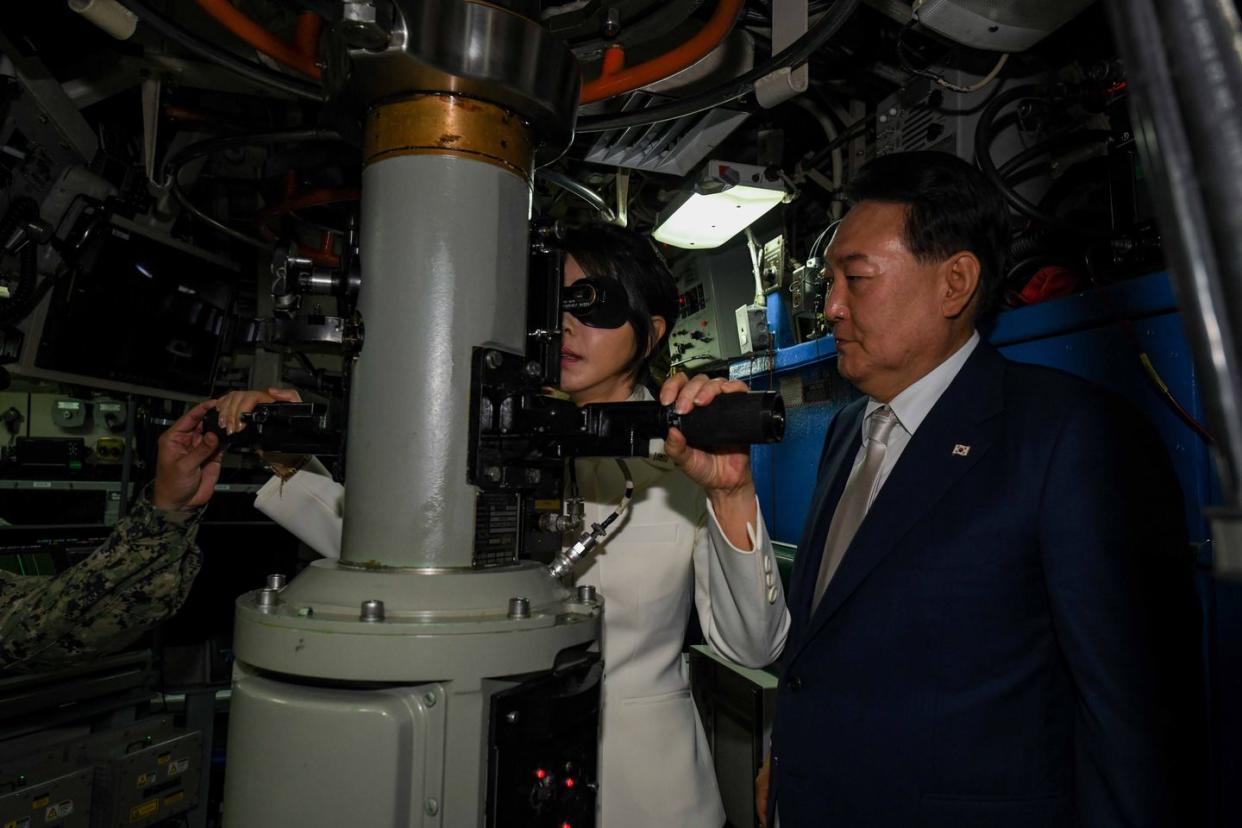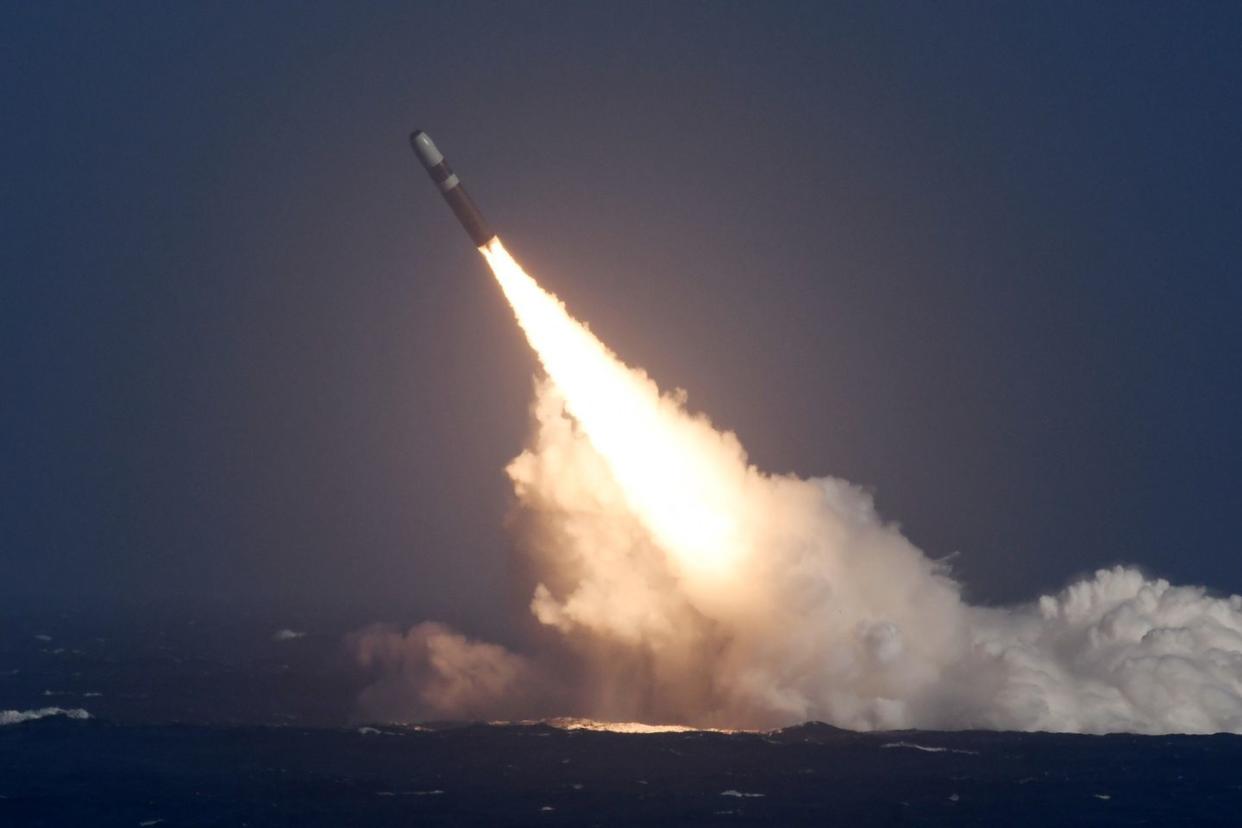The U.S. Sent a Silent Submarine to South Korea. Naturally, North Korea Freaked Out.

On July 18, the 170-meter-long Ohio-class nuclear-powered ballistic missile submarine Kentucky glided up to a quay in the port city of Busan, South Korea—located at the southeastern tip of the Korean peninsula—while under escort by two U.S. missile destroyers.

This was the first visit to South Korea by a U.S. submarine designed to lob intercontinental-range nuclear missiles in 42 years—one aimed at demonstrating what Biden described as the U.S’s “ironclad commitment” to extend nuclear deterrence to South Korea. South Korean president Yoon Suk Yeol, his wife, and members of the local press were invited onboard the submarine for a tour.
But just a few hours after Kentucky’s arrival, North Korea responded to the visit as gracefully as observers have come to expect—by launching two short-range ballistic missiles at 3:30 and 3:46 AM. According to South Korea’s military, the eastward-bound missiles traversed 340 miles, flying in a relatively shallow arc (with an apogee of 160,000 feet). The weapons demonstratively performed evasive maneuvers before splashing down into the Sea of Japan without incident.
Shortly after the US ballistic missile submarine USS Kentucky (SSBN-737) arrived in South Korea, North Korea fired two ballistic missiles into the sea at roughly the same distance as to Busan where the submarine is docked with 90 nuclear warheads onboard. https://t.co/utuK3sF4Zt pic.twitter.com/QYAWo1bo2V
— Hans Kristensen (@nukestrat) July 19, 2023
North Korea’s defense ministry stated with characteristic maximalism the visit might “incite the worst crisis of nuclear conflict.” Kim Yo Jong, sister to North Korean dictator Kim Jong Un, also claimed that “the foolish act…[and] extended deterrence system and excessively extended military alliance system” would cause North Korea to “go farther away” from the negotiating table.
Lately, North Korea has also been mad about U.S. surveillance flights over nearby international airspace—a North Korean spokesperson threatened that “...there is no guarantee that such a shocking accident as the downing of the U.S. Air Force strategic reconnaissance plane will not happen.” In addition, the country was upset about the meeting of a Nuclear Consultation Group between South Korea and the U.S., designed to work out how they would collaboratively respond to a North Korean nuclear attack.
Ironically, while the nuclear-armed Kentucky may be one of the most destructive weapon systems on the planet, it’s probably incapable of harming North Korea while visiting South Korea. Indeed, the symbolic visit is likely aimed more at influencing the leadership of South Korea than North Korea.
Why is Kentucky in South Korea?
Kentucky is one of 14 remaining nuclear-powered Ohio-class ballistic missile submarines (known as SSBNs or ‘boomers’). Four of the original 18 were converted to carry large numbers of non-nuclear Tomahawk cruise missiles. One such converted cruise missile sub (or SSGN), the USS Michigan, actually visited Busan about a month earlier for a “special warfare exercise.” This exercise occurred with a drydeck shelter visible on its deck—likely for transporting exotic reconnaissance systems—as seen in the last visit in 2017.

Meanwhile, the remaining Ohio-class SSBNs still carry up to 20 Trident II D5 ballistic missiles (down from 24 to meet a New START treaty requirement), each armed with multiple nuclear warheads that can threaten targets over 8,000 miles away. Thanks to nuclear propulsion, the submarines can quietly cruise underwater for two to three months.
The Kentucky’s port visit is an unusual event, as the Navy usually exposes its SSBN fleet to the minimum of public scrutiny—which one would expect of such apocalyptic weapons.
That said, South Korea became the first Pacific country ever visited by an American SSBN when USS Sam Houston buzzed by Chinhae in December of 1976. The Carter administration had wanted to reassure South Korea of the U.S.’s security commitment after withdrawing nuclear weapons from South Korean soil and pressuring the country to abandon its nuclear weapons program. The withdrawn nukes included Nikes-Hercules air defenses missiles, and MGR-1 Honest John, and MGM-29 Sergeant tactical ballistic missiles.

Thirty-four additional port visits by earlier-generation U.S. boomers followed before the program was abruptly and mysteriously discontinued after a final visit by SSBN Robert E. Lee in March of 1981. In 1991, the U.S. withdrew its last remaining tactical nuclear weapons from Korean soil—including various nuclear gravity bombs, artillery shells and even nuclear landmines (ADMs).
Over 40 years later, the U.S. first announced plans to resume periodic U.S. SSBN visits to South Korean ports late in April, following a trip to Washington by South Korean president Yoon Suk-yeol—though, date of the first visit wasn’t specified at the time to preserve operational security.

But the visit to Busan should be read as a symbolic act, not a direct projection of military power.
First of all, the Kentucky doesn’t pose any sort of enhanced threat to North Korea when visiting South Korea, as its intercontinental-range ballistic missiles are designed to engage targets from over 7,400 miles away.
In fact, the Kentucky’s Trident II D5 nuclear missiles are likely entirely incapable of threatening North Korea when visiting South Korea, as they’re estimated to possess a minimum range of 1,200 miles or more. Quite simply, a ballistic missile lobbed into the stratosphere with enough force to send it across the Pacific Ocean can’t pull off a hairpin turn to hit a target ‘just’ a few hundred miles away.

The Kentucky, therefore, actually poses a much greater threat when it’s lurking far away than in a South Korean port. There, instead of being able to hide out of sight, it’s observable and within easy striking range of North Korea’s military.
Kentucky’s visit is really aimed at South Korea, not North Korea. In particular, it’s aimed at reassuring South Korea’s leadership that it is reliably protected by U.S. nuclear deterrence at a time when there is growing domestic support for South Korea developing its own nuclear weapons. That’s something that South Korea could do very quickly, due to its mature civilian nuclear power sector and prior military research.
For now, South Korea still abides by a 1992 agreement with North Korea (which the latter flagrantly violated) not to test, build, or deploy nuclear weapons.
Of course, the visit also officially serves as a warning to North Korea over its vigorous testing of a wide variety of nuclear-weapon delivery systems in the last few years. The country has launched more than 100 since 2022.
Most recently, on July 11, that list of launches grew to include a solid-fuel variant of the Hwasong-18 intercontinental ballistic missile, which demonstrated enough energy to reach deep inside the continental United States. Compared to liquid-fueled missiles—which must be laboriously gassed-up prior to firing—solid-fuel missiles can be fired on very short notice, greatly reducing visible forewarning to surveillance assets.
However, the U.S. is probably not so deluded to think that the Kentucky’s visit will greatly affect North Korea’s resolve, as countless other warnings and shows of force over decades have failed to do so. Instead, the visit simply reminds North Korea that—at any given time—multiple SSBNs are lurking faraway in the Pacific ocean, and North Korea’s military simply has no realistic ability to locate and attack preemptively.
Nicknamed the “Thoroughbred of the Fleet,” SSBN 737 Kentucky was launched in 1990 at the Electric Boat shipyard in Groton, Connecticut, its low-carbon steel alloy hull christened with bourbon in homage to its namesake state.

In 1998, Kentucky collided with the Los Angeles-class attack-submarine San Juan during a training mission, damaging the boomer’s diving planes and, more seriously, breaching San Juan’s forward ballast tanks. Fortunately, no injuries resulted, and San Juan remains in service today. Kentucky, meanwhile, underwent its mid-life overhaul and nuclear refueling between 2012 and 2015, and resumed service in the U.S. Pacific Fleet’s Submarine Squadron 17 (SUBRON 17) based at Naval Base Kitsap in Bangor, Washington.
It remains unclear how long Kentucky will stay in Busan.
You Might Also Like
